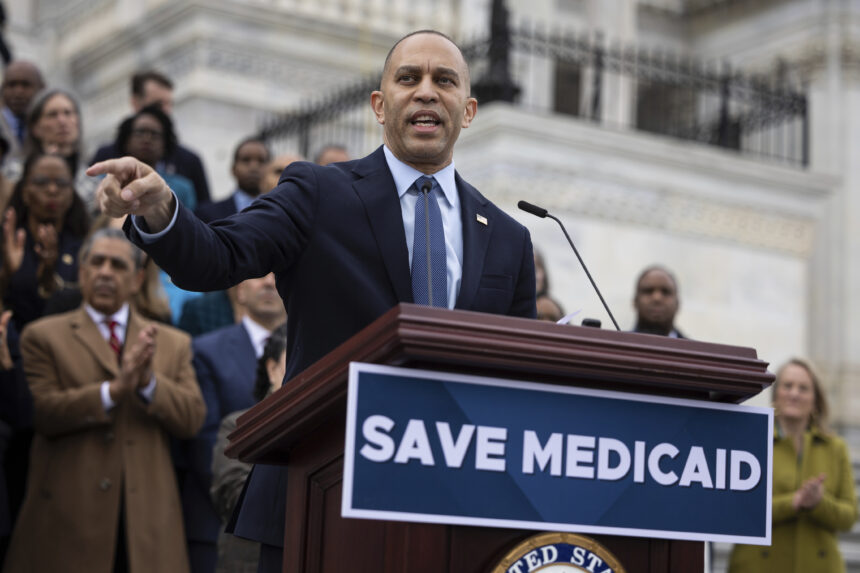Democrats are gearing up for the 2026 midterms with a powerful weapon in hand – President Donald Trump’s tax-and-spend megabill. The bill, which passed on Thursday, has ignited a wave of enthusiasm among Democrats as they look to reclaim the House. Ad-makers are already preparing attack ads to air in key states like Pennsylvania, Michigan, and Wisconsin as soon as the holiday weekend is over.
House Democrats are strategizing to make the most of the August recess by launching town halls and organizing programs to engage voters. They see an opportunity to expand the battleground by targeting red areas across the country. The passage of the megabill has sparked interest among potential candidates in traditionally Trump-leaning districts, with the House Majority PAC reporting a surge in candidate recruitment.
One Democratic lawmaker, Rep. Jared Golden of Maine, who represents a district that Trump won by 9 points, expressed confidence in explaining the bill to his constituents, calling it a “giant tax giveaway to wealthy people.” This sentiment is echoed by many Democrats who view the bill as a clear opportunity to highlight the disparity in its impact.
Following a series of recent developments, including the announcement of key Republican lawmakers like Sen. Thom Tillis and Rep. Don Bacon not seeking reelection, Democrats are feeling optimistic about their chances in the upcoming midterms. They have also shown a more unified front in pushing back against the bill, with House Democratic Leader Hakeem Jeffries leading the charge with a powerful speech on the House floor.
However, Democrats are aware that many Americans are still unaware of the details of the megabill, including its significant cuts to Medicaid and food assistance programs. To bridge this gap, Democrats are ramping up their efforts to educate voters and expand their campaign efforts to more districts across the country.
Some Democratic strategists are urging the party to capitalize on this momentum by investing in early, paid communications to shape voters’ views early on. They emphasize the importance of mobilizing early and taking risks to influence public opinion in favor of the party’s agenda.
On the other side, Republicans are planning to highlight the tax cuts and increased funding for border security included in the megabill. They aim to neutralize Democratic attacks on Medicaid cuts by framing them as necessary reforms to eliminate waste and fraud. Republicans believe that Democrats’ support for the bill will backfire, portraying them as out of touch with the concerns of everyday Americans.
Despite Republicans’ efforts to sell the bill, public polling shows a bleak outlook, with most Americans disapproving of it by a significant margin. Democratic groups like Priorities USA and Navigator Research have also found that a majority of voters are not fully aware of the megabill, indicating a need for increased awareness and education on its implications.
As the 2026 midterms approach, both Democrats and Republicans are gearing up for a fierce battle over the megabill and its impact on the country. With Democrats seizing the opportunity to wield the bill as a cudgel against their opponents, and Republicans looking to defend their stance, the political landscape is set for an intense and high-stakes showdown.
A recent survey revealed that only 8 percent of respondents were aware that the GOP legislation included cuts to Medicaid. This lack of knowledge was particularly prevalent among passive or avoidant news consumers, a demographic that Democrats struggled to engage with during the 2024 elections.
Danielle Butterfield, the executive director of Priorities USA, emphasized the need for the Democratic party to effectively communicate the impacts of the bill to voters who may not be actively following politics. She suggested moving beyond statistics and instead focusing on personal stories to connect with voters. Butterfield recommended utilizing online platforms like YouTube for advertising campaigns, in addition to traditional TV ads.
One potential storyteller is Nathan Sage, a first-time candidate and Iraq War veteran running against Iowa Sen. Joni Ernst. Sage, who has personal experience relying on food assistance, highlighted the disconnect between the Republican agenda and its impact on working-class individuals. He noted that many Iowans felt misled by promises of tax breaks, only to realize the detrimental effects of the GOP bill on programs like Medicaid.
In a state like Iowa, where Democrats have struggled to win over white, working-class voters, Sage and Democratic pollster Brian Stryker see an opportunity to reclaim support. Stryker pointed out that the Medicaid cuts could serve as a rallying point for working-class voters, potentially swaying their allegiance in future elections.
Looking ahead, Sage emphasized the importance of electing candidates who truly represent and advocate for working-class interests. He underscored the need for voters to recognize that politicians may not have their best interests at heart and that change can only come from within by electing representatives who understand and prioritize the needs of working-class individuals.
In conclusion, the GOP legislation’s cuts to Medicaid have the potential to galvanize working-class voters and reshape political dynamics in states like Iowa. By highlighting the real-world implications of these cuts and advocating for candidates who prioritize working-class interests, Democrats may have a chance to win back support from key demographics in future elections.







